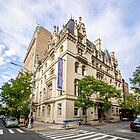Wikipedia Today's featured article
From today's featured article
Anna Blackburne (1726–1793) was an English botanist and collector. She was born at Orford Hall in Lancashire into a family of landowners and after her mother's death she remained there with her father, John Blackburne, who had hothouses for exotic plants and an extensive library. Blackburne taught herself Latin so she could read the Systema Naturae of Carl Linnaeus, and created a natural history museum where she collected insects, shells, minerals and birds. She knew the naturalist Johann Reinhold Forster, who instructed her in entomology, and corresponded with other naturalists including Linnaeus. Her brother Ashton, who lived in New York, sent her specimens of North American birds, which were described by the naturalist Thomas Pennant in his Arctic Zoology. After her father's death, Blackburne and her museum moved to nearby Fairfield Hall. After her death, her nephew John Blackburne inherited her collection. Several species are named for her, including the Blackburnian warbler. (Full article...)
From tomorrow's featured article
The horned sungem (Heliactin bilophus) is a species of hummingbird native to Brazil, Bolivia and Suriname. It prefers open habitats such as savanna, grassland and garden, and expanded its range into southern Amazonas and Espírito Santo, probably due to deforestation. It is a small hummingbird with a long tail and a short, black bill. The sexes differ in appearance, with males having two shiny red, golden, and green feather "horns" above the eyes, a shiny blue head crest and a black throat with a pointed "beard". The female is plainer, with a brown or yellow–buff throat. It is a nomadic species, responding to the seasonal flowering of its food plants. If a flower's shape is unsuited to the bird's short bill, it may rob nectar through a hole at its base. It also eats small insects. Only the female builds the small cup nest, incubates the two white eggs, and rears the chicks. The species is currently classified as least concern, and its population is thought to be increasing. (Full article...)
From the day after tomorrow's featured article
The Felix M. Warburg House is a mansion at 1109 Fifth Avenue on the Upper East Side of Manhattan in New York City. It was built from 1907 to 1908 for the German-American Jewish financier Felix M. Warburg, in the Châteauesque style, and designed by C. P. H. Gilbert. After Warburg's death in 1937, his widow sold it to a real estate developer. When plans to replace it with luxury apartments fell through, ownership reverted to the Warburgs, who donated it in 1944 to the Jewish Theological Seminary of America. In 1947, the Seminary opened the Jewish Museum in the mansion. The house was named a New York City designated landmark in 1981 and was added to the National Register of Historic Places in 1982. In 1993, Kevin Roche constructed an annex to the house in Gilbert's style, built with stone from the same quarry that supplied the original mansion. Critical reviews of the original house's architecture have generally been positive while the extension received a mixed reception. (Full article...)


